Installing a rear-facing infant car seat can seem daunting. But it’s crucial for your baby’s safety.
Parents want to ensure their infant’s safety during every car ride. Installing a rear-facing car seat correctly is a key step. This guide will help you through the process with clear, easy steps. You don’t need to be an expert to do this.
With a little patience and attention, you can install the seat securely. This will give you peace of mind and keep your baby safe. Let’s get started on how to install your rear-facing infant car seat.

Credit: www.healthychildren.org
Choosing The Right Car Seat
Choosing the right car seat for your infant is crucial. It ensures their safety during car rides. This guide will help you select the best rear-facing infant car seat. Let’s look at the key factors to consider.
Safety Standards
Check if the car seat meets all safety standards. Look for labels indicating crash test approval. Ensure the seat has a five-point harness. This harness secures your baby at the shoulders, hips, and between the legs.
Age And Weight Recommendations
Each car seat has specific age and weight guidelines. Rear-facing seats are best for infants. Usually, they support babies up to 35 pounds. Always follow the manufacturer’s recommendations.

Credit: www.tinyhood.com
Preparing Your Vehicle
Installing a rear-facing infant car seat can be a daunting task. But with the right preparation, it becomes much easier. This section will guide you through the necessary steps to get your vehicle ready for the car seat installation. Let’s start by understanding the key aspects of preparing your vehicle.
Reading The Car Manual
Your car manual is your best friend. It provides specific instructions on where and how to install a car seat. Every vehicle is different. So, it’s important to read the manual carefully.
Look for the section dedicated to child safety seats. It will have details about the LATCH system and seat belt usage. Pay attention to the weight limits and installation methods. This information ensures you install the car seat correctly and safely.
Selecting The Best Location
Choosing the right spot for the car seat is crucial. The safest place is usually the back seat, away from active airbags. Here are some factors to consider:
- Middle seat: It’s often the safest because it is farthest from side impacts.
- Side seats: If the middle seat is not an option, choose a side seat.
- Rear-facing: Ensure the car seat is rear-facing for infants under two years old.
Check if your vehicle has the LATCH system or if you need to use the seat belt for installation. Ensure the seat is level and stable. A properly installed car seat should not move more than an inch in any direction.
By following these steps, you can make sure your vehicle is ready for a safe car seat installation. Always double-check your work to ensure the highest level of safety for your child.
Installing The Base
Installing the base of a rear-facing infant car seat is crucial for safety. The base must be secure to protect your baby in case of an accident. Follow these steps to ensure the base is installed correctly.
Using The Latch System
The LATCH system (Lower Anchors and Tethers for Children) makes installation easier. First, locate the lower anchors in your car seat. They are usually found between the seat cushions.
Next, attach the connectors on the car seat base to these anchors. Push down firmly on the base while tightening the straps. Check that there is no wiggle room.
Finally, make sure the base is level. Many car seats have indicators to help with this. Adjust as needed until the base is correctly positioned.
Securing With Seat Belt
If your car does not have the LATCH system, you can use the seat belt. Place the base on the car seat and thread the seat belt through the belt path. Lock the seat belt by pulling it all the way out and letting it retract.
Push down on the base while tightening the seat belt. This ensures a snug fit. There should be no more than an inch of movement side-to-side or front-to-back.
Lastly, check the level indicators on the base. Adjust the base if needed to achieve the correct angle. Your baby’s safety depends on a secure and level installation.
Attaching The Car Seat
Attaching a rear-facing infant car seat correctly is crucial for your baby’s safety. Follow these steps to ensure the car seat is secure and properly installed. This guide will help you achieve a snug fit, ensuring your child’s safety during travel.
Correct Angle Positioning
First, check your car seat’s instructions for the correct angle. Most infant car seats have angle indicators or adjusters. These help you find the right recline. The seat should be at a 45-degree angle. This prevents your baby’s head from flopping forward, which can obstruct breathing.
If your car seat does not have a built-in adjuster, you can use a rolled towel. Place it under the base to achieve the correct angle. Always double-check the angle before securing the seat.
Ensuring A Tight Fit
Once the angle is correct, secure the car seat using the vehicle’s seat belt or LATCH system. Route the seat belt or LATCH strap through the car seat’s base. Buckle the seat belt or attach the LATCH connectors. Tighten the belt or strap until the car seat does not move more than an inch side to side.
Push down on the car seat base with your knee or hand while tightening. This helps remove slack and ensures a snug fit. Check for movement again. The car seat should feel secure and stable.
Adjusting Harness Straps
Adjusting the harness straps is crucial for your infant’s safety. The straps need to fit snugly and comfortably. This ensures your baby is secure during car rides. Below are steps to properly adjust the harness straps.
Proper Strap Position
The harness straps should be at or below your baby’s shoulders. This helps keep your baby in the seat during a crash. To adjust, first place your baby in the seat. Check the strap height. If it’s too high or too low, adjust the straps. Move the straps to the correct slots. Ensure the straps lay flat and are not twisted.
Checking Tightness
Once the straps are in the correct position, check their tightness. A loose harness can be dangerous. Tighten the straps until you can fit only one finger under them. This is called the “pinch test.” If you can pinch the strap, it is too loose. Adjust until the strap passes the pinch test. Ensure the chest clip is at armpit level. This keeps the harness straps in place.
Final Safety Checks
Ensuring your infant car seat is installed correctly is crucial. The final safety checks are essential to guarantee your baby’s safety during every ride. This section covers the Wiggle Test and getting a Professional Inspection to confirm everything is in place.
Wiggle Test
Once the car seat is installed, perform the wiggle test. Grab the car seat at the base where it attaches to the vehicle. Try to move it side-to-side and front-to-back.
- The car seat should not move more than one inch.
- If it moves more, tighten the installation.
This test ensures the seat is snug and secure. A loose car seat can be dangerous. Don’t skip this step.
Professional Inspection
After you perform the wiggle test, consider a professional inspection. Many local fire stations and hospitals offer this service for free.
- Find a certified Child Passenger Safety Technician (CPST).
- Schedule an appointment for a car seat check.
- Bring your car seat manual and vehicle manual.
A professional can verify the installation and offer helpful tips. They can also adjust the car seat if necessary. This step provides peace of mind and ensures maximum safety.
Common Installation Mistakes
Installing a rear-facing infant car seat can be tricky. Many parents make common mistakes. These mistakes can compromise your child’s safety. Knowing these errors can help you avoid them. Here are some common installation mistakes to watch out for.
Loose Straps
Loose straps are a frequent mistake. Straps should be snug and secure. Check the straps every time you use the seat. A loose strap can cause serious injury. Always pull the strap tight. You should not be able to pinch any slack.
Incorrect Angles
The angle of the car seat is crucial. A rear-facing seat must be reclined correctly. Too upright, and your baby can slump forward. This can restrict their airway. Most seats have angle indicators. Use them. They help ensure the correct angle. Check the angle each time you install the seat.
Maintenance And Care
Maintaining and caring for your rear-facing infant car seat ensures your child’s safety and comfort. Regular checks and proper cleaning help extend the life of the seat. Let’s explore key steps to keep your car seat in top shape.
Regular Inspections
Frequent inspections are crucial. Check the seat for any signs of wear and tear. Look for frayed straps, broken buckles, or loose parts. Ensure the seat is securely installed. Tug the seat to see if it moves more than an inch. If it does, tighten the installation.
Inspect the harness system. Make sure the straps are not twisted and the buckles work correctly. Confirm that the seat recline angle is appropriate. An improper angle can affect your baby’s breathing.
Cleaning And Storage
Keeping the car seat clean is vital. Read the manufacturer’s instructions before cleaning. Most seats have removable covers. Wash the cover with mild soap and water. Avoid bleach as it can damage the fabric. Air dry the cover to prevent shrinking.
Wipe down the plastic parts with a damp cloth. Use a vacuum to remove crumbs and debris from the seat. Avoid using harsh chemicals that can weaken the seat materials.
Proper storage is important. If you need to store the seat, keep it in a cool, dry place. Avoid areas with high humidity or direct sunlight. This prevents the seat from becoming brittle or discolored.
Follow these maintenance steps to ensure your rear-facing infant car seat remains safe and reliable for your child.

Credit: csftl.org
Frequently Asked Questions
How Do You Install A Rear-facing Car Seat?
Install the seat in the back seat. Follow the manufacturer’s instructions. Ensure the base is level. Secure it tightly using the seat belt or LATCH system. Make sure it doesn’t move more than an inch.
What Angle Should The Car Seat Be?
The car seat should be at a 45-degree angle. This ensures the baby’s airway remains open. Check the seat’s built-in angle indicator.
Can A Rear-facing Car Seat Go In The Front Seat?
No, a rear-facing car seat should never be in the front seat. The airbag can cause serious injury or death. Always place it in the back seat.
How Tight Should The Car Seat Be Installed?
The car seat should not move more than one inch side-to-side or front-to-back. Ensure it’s securely fastened using the seat belt or LATCH system. Check for tightness regularly.
Conclusion
Proper installation of a rear-facing infant car seat ensures your child’s safety. Follow each step carefully and double-check your work. Secure the seat tightly using the car’s seat belt or LATCH system. Ensure the harness fits snugly on your baby.
Regularly inspect the seat for wear and tear. Refer to the car seat manual for any questions. Safe travels with your little one start with proper installation.
